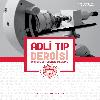KODEİN VE KODEİN İÇEREN TIBBİ MÜSTAHZARLAR HAKKINDAUZMAN GÖRÜŞÜ
EXPERT OPINION ON CODEINE AND CODEINE CONTAINING DRUGS
___
- 1. Randall CB. Disposition of Toxic Drugs and Chemicals in Man. 7th Edition. Biomedical Publication, Foster City, California, 2004.
- 2. Polson CJ, Green MA, Lee MR. Clinical Toxicology. 3rd Edition. Pitman Books Limited, London, 1983.
- 3. Howard BG, Huda A. Opioid analgesics, In: Hardman JG, Limbird LE, Goodman A, eds. Goodman&Gilman's The Pharmacological Basis of Therapeutics.10th Edition. McGraw Hill, New York, 2001.
- 4. Tijani AY, Salawu OA, John-Africa LB, Sadiq A, Chindo BA. Behavioural effects of Benylin-Codein in mice. Nature and Science 2012;10(4):83-8.
- 5. Koren G, Cairns J, Chitayat D, Gaedigk A, Leeder SJ. Pharmacogenetics of morphine poisoning in a breastfed neonate of a codeine-prescribed mother. Lancet 2006;368(9536):704.
- 6. Kayaalp SO. Türkiye İlaçla Tedavi Kılavuzu TİK-6. Pelikan Yayıncılık Ltd. Şti., Ankara, 2011.
- 7. Katzung BG. Basic & Clinical Pharmocology. 10th Edition. The McGraw-Hill Companies, New York, 2007.
- 8. Eichelbaum M, Evert B. Influence of pharmacogenetics on drug disposition and responce. Clin Exp Pharmacol Physiol 1996;23:983-5.
- 9. Martindale: The Complet Drug Referance. The Pharmaceutical Press, London, 2007.
- 10. Dökmeci İ, Dökmeci AH. Türkiye İlaç Rehberi. 4.baskı, Nobel Tıp Kitapevleri Ltd.Şti, İstanbul, 2004.
- 11. Single Convention on Narcotic Drugs, 1961.
- 12. Legal topic overviews: classification of controlled drugs. EMCDDA publication, Lisbon (http://www.emcdda.europa.eu/html.cfm/index5622EN.htmlErişim tarihi 25.06.2013).
- 13. Ishigooka J, Yoshida Y, Murasaki M. Abuse of "DRO No": a Japanese O.T.C. cough suppressant solution containing methylephedrine, codeine, caffeine and chlorpheniramine. Prog Neuropsychopharmacol Biol Psychiatry 1991;15(4):513-21.
- 14. Jinks KJ, Raschko RR. A profile of alcohol and prescription drug abuse in high risk community based elderly population. Drug Information in Clinical Practice 1990;24(10):971-5.
- 15. Mattoo SK, Basu D, Balaji M, Sharma A, Malhotra A. Subtypes of codeine cough syrup abusers. Indian J Med Sci 1999;53(3):97-102.
- 16. Frei MY, Nielsen S, Dobbin MD, Tobin CL. Serious morbidity associated with misuse of over-the-counter codeine-ibuprofen analgesics: a series of 27 cases. Med J Aust 2010;193(5):294- 6.
- 17. Martin JD. Nurofen Plus misuse: an emerging cause of perforated gastric ulcer. Med J Aust 2008;188(1):56-7.
- 18. Chetty R, Baoku Y, Mildner R, Banerjee A, Vallance D, Haddon A, Labib M. Severe hypokalaemia and weakness due to Nurofen misuse. Ann Clin Biochem 2003;40(4):422-23.
- 19. DEA warns of soft drink-cough syrup mix, by Donna Leinwand (USA TODAY gazetesi, 19.10.2006, Erişim tarihi:10.08.2012).
- 20. Peters RJ, Kelder SH, Markham CM, Yacoubian GS, Peters LA, Ellis A. Beliefs and social norms about codeine and promethazine hydrochloride cough syrup (CPHCS) onset and perceived addiction among urban Houstonian adolescents: an addiction trend in the city of lean. J Drug Educ 2003;33(4):415-25.
- 21. Peters R, Yacoubian GS, Rhodes W, Forsythe KJ, Bowers KS, Eulian VM, Mangum CA, O'Neal JD, Martin Q, Essien EJ. Beliefs and social norms about codeine and promethazine hydrochloride cough syrup (CPHCS) use and addiction among multi-ethnic college students. J Psychoactive Drugs 2007;39(3):277-82.
- 22. Davis II, Baum C, Graham DJ. Indices of drug misuse for prescription drugs. International Journal of Addiction 1991;26(7)777-95.
- 23. Gerostamoulos J, Burke MP, Drummer OH. Involvement of codeine in drugrelated deaths. Am J Forensic Med Pathol 1996;17(4):327-35.
- 24. Mattoo SK, Basu D, Sharma A, Balaji M, Malhotra A. Abuse of codeine-containing cough syrups: a report from India. Addiction 1997;92(12):1783-7.
- 25. Daniel TL Shek, Ching-Man Lam. Adolescent cough medicine abuse in Hong Kong: implication fort he design of positive youth development programs in Hong Kong. Int J Adolesc Med Health 2006:18(3)493-503.
- 26. Darboe MN. Abuse of dextromethorphan-based cough syrup as a substitute for licit and illicit drugs: A theoretical framework. Adolescence 1996;31(121):239-45.
- 27. Darboe MN, Keenan GR, Richards TK. The abuse of dextromethorphan-based cough syrup: a pilot study of the community of Waynesboro, Pennsylvania. Adolescence 1996;31(123):633-44.
- 28. Suzuki T, Masukawa Y, Misawa M. Drug interactions in the reinforcing effects of over-the-counter cough syrups. Psychopharmacology 1990;102(4):438-42.
- 29. Borde M, Nizamie SH. Dependence on a common cough syrup. Lancet 1988;1(8588):760-1.
- 30. Wairagkar NS, Das J, Kumar S. Codeine containing cough syrup addiction in Assam and Nagaland. Indian Journal of Psychiatry 1994;36(3):129-32.
- 31. Friedman RA, House JW, Luxford WM, Gherini S, Mills D. Profound hearing loss associated with hydrocodone/acetaminophen abuse. Am J Otol 2000;21(2):188-91.
- 32. Blakley BW, Schilling H. Deafness associated with acetaminophen and codeine abuse. J Otolaryngol Head Neck Surg 2008;37(4):507-9.
- 33. Oh AK, Ishiyama A, Baloh W. Deafness associated with abuse of hydrocodone/acetaminophen. Neurology 2000;54(12):2345.
- 34. Jensen S, Hansen AC. Abuse of codeine separated from over-the-counter drugs containing acetylsalicylic acid and codeine. Int J Legal Med 1993;105(5):279- 81.
- 35. Fleming GF, McElnay JC, Hughes CM. The separation of codeine from nonprescription combination analgesic products. Subst Use Misuse 2003;38(9):1217-2
- ISSN: 1018-5275
- Yayın Aralığı: 3
- Başlangıç: 1985
- Yayıncı: BAYT Yayıncılık
2005 YILINDA YÜRÜRLÜĞE GİREN TÜRK CEZA KANUNU'NUN (TCK) CERRAHİ BRANŞ HEKİMLERİ ÜZERİNDEKİ ETKİSİ
Ali KOCATAŞ, Gökhan DEMİRAL, Ahmet YILMAZ, Oktay YENER, Salih BÖLÜK, Gürol ŞAHİN
ESKİŞEHİR'DE ERKEK ÇOCUK VE ADÖLESANLARA YÖNELİK CİNSEL SALDIRI OLGULARI
Mehmet TOYGAR, Kenan KARBEYAZ, Harun AKKAYA
GÖZ YARALANMALARI: ADLİ OLGULARIN DEĞERLENDİRİLMESİ
Mustafa Talip ŞENER, Sadullah KELEŞ, Muhammed Ziya KIR
YAŞLI ÇİFTİN İKİLİ ÖLÜMÜ: OLAY YERİNİN ROLÜ
Eyyüp YILMAZ, Süleyman GÖREN, Bülent DOĞAN, Ramazan AKÇAN
İDRARDA UYUŞTURUCU TESTİNİN TAĞŞİŞ EDİLMESİ: OLGU BİLDİRİSİ VE DERLEME
BALDIRAN OTU ZEHIRLENMESINE BAĞLI ÖLÜM: OLGU SUNUMU
İbrahim ÜZÜN, Bahadır KUMRAL, Mehmet ÖZBAY, Taşkın ÖZDEŞ, Yalçın BÜYÜK
KULAK KEPÇESİ MORFOLOJİSİNDEN KİMLİKLENDİRMEDE GÖZLEMCİ CİNSİYETİNİN ETKİLERİNİN ARAŞTIRILMASI
Mahmut AŞIRDİZER, Mehmet Sunay YAVUZ, Beyhan ÖZYURT, Ertuğrul TATLISUMAK
KODEİN VE KODEİN İÇEREN TIBBİ MÜSTAHZARLAR HAKKINDAUZMAN GÖRÜŞÜ
Mustafa ÖZCAN, Faruk AŞICIOĞLU, Mustafa OKUDAN, Sefa SAYGILI, Latif İLHAN, Mustafa IRAZ
